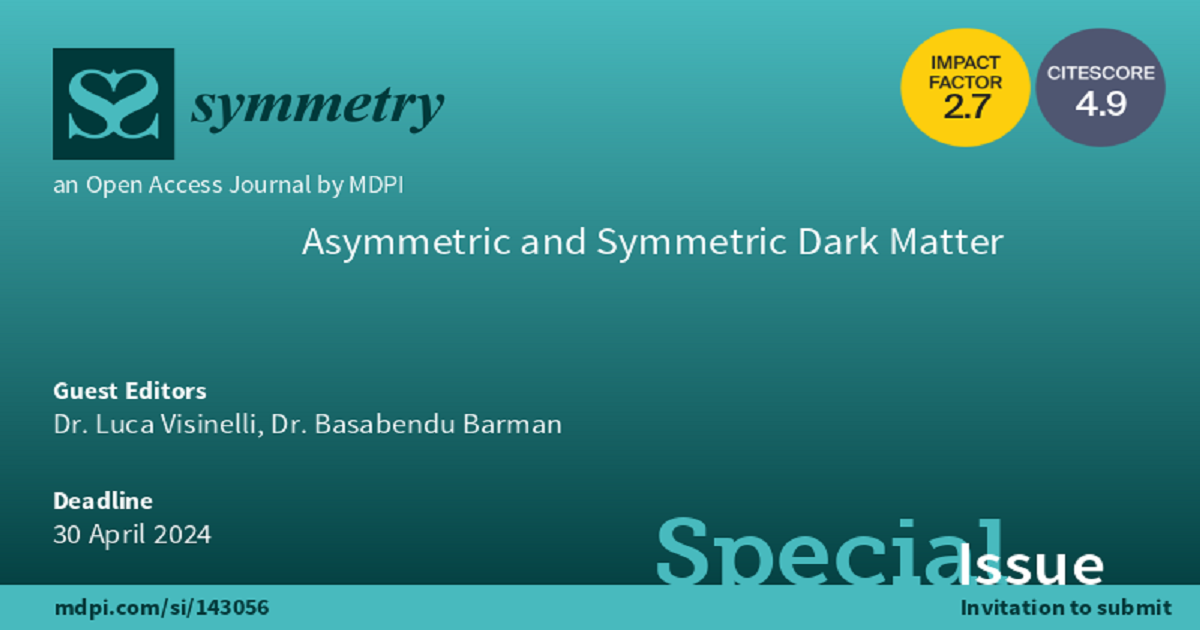Asymmetric and Symmetric Dark Matter
A special issue of Symmetry (ISSN 2073-8994). This special issue belongs to the section "Physics".
Deadline for manuscript submissions: closed (30 April 2024) | Viewed by 1102

Special Issue Editors
2. School of Physics and Astronomy, Shanghai Jiao Tong University, 800 Dongchuan Road, Shanghai 200240, China
Interests: cosmology; particle astrophysics; axions
Special Issues, Collections and Topics in MDPI journals
Special Issue Information
Dear Colleagues,
Dark matter has affected the properties and the expansion rate of the Universe throughout its history, yet this mysterious component is still unexplained. Its discovery would significantly advance our understanding of the law of physics and the fate of the cosmos. As conventional dark matter candidates fail to be observed in laboratories, we urge researchers to apply new ideas to address this open question.
As such, one can gain inspiration from the asymmetry between the number densities of particles and antiparticles, which is manifest in the present Universe. It is reasonable to ask whether the asymmetry that is present in the visible sector also lurks in the invisible component of the Universe, which might comprise dark matter and other undiscovered particles. A possible hint at this relation is the fact that the baryonic and dark components have a comparable share in the matter budgets, with the mass of dark matter amounting to about five times that of visible matter.
The aim of the present Special Issue is to underline the role of asymmetric dark matter models in all aspects of their searches, spanning from model building to cosmological and astrophysical signatures, as well as the phenomenological implications of a direct detection and prospects in colliders.
We are soliciting contributions (research and review articles) covering a broad range of topics on asymmetric dark matter, including (though not limited to) the following:
- Model building involving asymmetric dark matter;
- Direct and indirect searches for asymmetric dark matter;
- Current and future collider signatures;
- Cosmological modeling with asymmetric dark matter;
- Indirect probes of the dark sector.
Dr. Luca Visinelli
Dr. Basabendu Barman
Guest Editors
Manuscript Submission Information
Manuscripts should be submitted online at www.mdpi.com by registering and logging in to this website. Once you are registered, click here to go to the submission form. Manuscripts can be submitted until the deadline. All submissions that pass pre-check are peer-reviewed. Accepted papers will be published continuously in the journal (as soon as accepted) and will be listed together on the special issue website. Research articles, review articles as well as short communications are invited. For planned papers, a title and short abstract (about 100 words) can be sent to the Editorial Office for announcement on this website.
Submitted manuscripts should not have been published previously, nor be under consideration for publication elsewhere (except conference proceedings papers). All manuscripts are thoroughly refereed through a single-blind peer-review process. A guide for authors and other relevant information for submission of manuscripts is available on the Instructions for Authors page. Symmetry is an international peer-reviewed open access monthly journal published by MDPI.
Please visit the Instructions for Authors page before submitting a manuscript. The Article Processing Charge (APC) for publication in this open access journal is 2400 CHF (Swiss Francs). Submitted papers should be well formatted and use good English. Authors may use MDPI's English editing service prior to publication or during author revisions.
Keywords
- cosmology
- dark matter
- asymmetric dark matter
- direct and indirect detection
- model building
- dark radiation
- collider signatures
- indirect probes of the dark sector
- axions
- weakly interacting massive particles
- hidden sectors, dark photon
Benefits of Publishing in a Special Issue
- Ease of navigation: Grouping papers by topic helps scholars navigate broad scope journals more efficiently.
- Greater discoverability: Special Issues support the reach and impact of scientific research. Articles in Special Issues are more discoverable and cited more frequently.
- Expansion of research network: Special Issues facilitate connections among authors, fostering scientific collaborations.
- External promotion: Articles in Special Issues are often promoted through the journal's social media, increasing their visibility.
- e-Book format: Special Issues with more than 10 articles can be published as dedicated e-books, ensuring wide and rapid dissemination.
Further information on MDPI's Special Issue polices can be found here.






